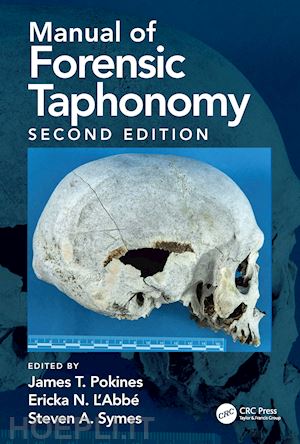James T. Pokines, Ph.D., D.-.A.B.F.A., is an Associate Professor in the Forensic Anthropology Program, Department of Anatomy and Neurobiology, Boston University School of Medicine. He is also the Forensic Anthropologist for the Office of the Chief Medical Examiner, Boston, Commonwealth of Massachusetts, and analyzes all unknown bone cases in that state. His prior experience includes twelve years as a Forensic Anthropologist and Manager at the Central Identification Laboratory, Hawaii, recovering and analyzing the remains of missing servicemembers from past conflicts. His field experience includes excavations in 18 countries, including modern forensic scenes in multiple countries, Tiwanaku sites in Bolivia, a Classical site in Egypt, modern scavenger dens in Kenya, and Paleolithic sites in Spain, France, and Jordan. He has ongoing research in the latter country, including the natural faunal trap site Wadi Zarqa Ma'in 1 and multiple Paleolithic sites in the Azraq basin, His taphonomic interests include scavenger gnawing and dispersal, subaerial weathering, and other environmental effects to bone, and he also researches zooarchaeology, paleoecology, and Paleolithic archaeology. He received his B.A. degree in Anthropology and Archaeology at Cornell University and his M.A. and Ph.D. degrees in Anthropology from the University of Chicago and is a former Vice President of the American Board of Forensic Anthropology and a current Fellow of the American Academy of Forensic Sciences. Steven A. Symes, Ph.D., D.-A.B.F.A., is currently the Forensic Anthropologist for the Office of the Chief Medical Examiner in Jackson, Mississippi. He is Professor Emeritus of Forensic Anthropology at Mercyhurst University in Pennsylvania, and is an Adjunct Professor in the Department of Anatomy at the University of Pretoria, South Africa. He is a diplomate of the American Board of Forensic Anthropology and is a Fellow of the American Academy of Forensic Sciences. He is best known for his expertise in interpreting trauma to bone and a leading authority on saw and knife mark analysis. With over 30 years of experience, he has assisted federal, state, local, and non-US authorities in the identification, analysis, and documentation of those suspected to be victims of trauma. Dr. Symes has been qualified as an expert for both the prosecution and defense, testifying specifically on forensic tool mark and fracture pattern interpretation in bone, as well as blunt force, ballistic, burned and healing trauma in bone. Because of his specialty in criminal dismemberment and mutilation, he has worked a number of serial homicides, and has provided analysis of cut marks in nearly 200 dismemberment cases and approximately 400 knife wound cases. Ericka Noelle L’Abbé, Ph.D., D.-A.B.F.A., is a Professor of Biological Anthropology and the Director of the Forensic Anthropology Research Centre (FARC) in the Department of Anatomy at the University of Pretoria, South Africa. She is Board-certified with the American Board of Forensic Anthropology and is a Fellow of the American Academy of Forensic Sciences. She teaches undergraduate and postgraduate students in biological anthropology, human osteology, human evolution and research methodology. She has published numerous papers and book chapters in forensic anthropology, with more recent focuses on facial approximations, teaching human evolution, and the development of medical implants for South Africans. As Director of the FARC, she which is involved in a variety of activities including the analysis of human remains, both forensic and archaeological in nature, field and laboratory training, research, and repatriation. FARC also applies knowledge and research in biological anthropology for application in medicine and health sciences education. She has written 350 technical reports on unknown skeletal remains for forensic pathologists and the South African Police Service (SAPS). She currently manages an Erasmus+ Capacity Building Grant in Higher Education which aims to build the first digital repository of skeletal remains in Africa, known as Bakeng se Afrika project, for the purposes of research and education.











